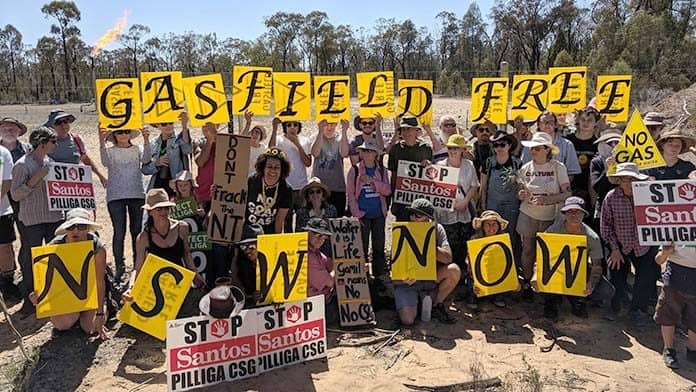Scott Morrison and the NSW Liberals have agreed to ramp up fossil fuel use through a fresh expansion of gas and coal production.
The deal requires the NSW government to boost gas supply as well as secure an increase in coal for the Mt Piper power station near Lithgow.
The now privatised power plant was forced to reduce output last year due to a coal shortage. The NSW government is working to help bail it out, with more public money going to subsidise coal.
The amount of new gas planned, 70 petajoules a year, is precisely the same amount that Santos will produce if its coal seam gas development at Narrabri in northwest NSW goes ahead.
Morrison has tried to present gas as climate friendly, claiming it as an “important transition fuel” to reduce emissions. But gas is still a fossil fuel that releases at least 60 per cent of the emissions of coal.
Gas import terminals use gas that is liquefied for transport on a ship and then regasified. This energy-intensive process, along with transporting, means that gas emissions are close to that of coal.
Even the official energy regulators don’t believe the use of gas for power generation needs to increase. The Australian Energy Market Operator’s projections show that we can dramatically expand renewable energy without this.
The NSW government’s decision on final approvals for the Narrabri gas project is expected within months.
Gamilaraay people and local communities have been campaigning against the development for years, alongside farmers organised through a Lock the Gate campaign. Santos plans up to 850 gas wells across the area, drilling through areas of the Great Artesian Basin to get at gas deposits underneath. This could see toxic chemicals contaminate water used for drinking and irrigation. It would also mean land clearing in the Pilliga State Forest, the largest remaining temperate woodland in eastern Australia with important spiritual significance for the Gamilaraay.
“Santos has failed to get support from regional communities here for their dangerous gasfield and so the Commonwealth Government has opted instead to flat-out bribe the New South Wales government,” Margaret Fleck, whose farm is not far from the gasfield, told the media.
There is also another option to meet the quota—building a new gas terminal at Port Kembla to import gas for domestic use. This is on a list of energy projects Scott Morrison want to underwrite with government funds and this deal requires the NSW government to support them.
The list includes an upgrade for the coal power station at Vales Point near Lake Macquarie. According to The Guardian, its owners have been told $11 million in funding will go ahead.
In exchange the federal government will hand over $2 billion to NSW, half of it for unspecified “emissions reductions initiatives”. Some of this may fund renewable energy projects, such as a proposed renewable energy zone in the state’s west. But this will also consolidate privatisation of the electricity sector, with projects to be delivered by energy corporations. And Morrison has suggested some of it could go to “coal innovation” to reduce emissions from coal.
The rest of the money will help fund new interconnectors to boost the power transmission grid, including a new link between Queensland and NSW. This should indirectly help renewable energy projects.
But Morrison’s plan is simply a bribe to force an expansion in coal and gas use. We need an end to all government subsidies for fossil fuels, not further handouts for the industry. Government spending and public ownership is badly needed to drive a rapid transition to 100 per cent renewable energy. We need to build a climate movement that can fight to make this happen.
By James Supple






